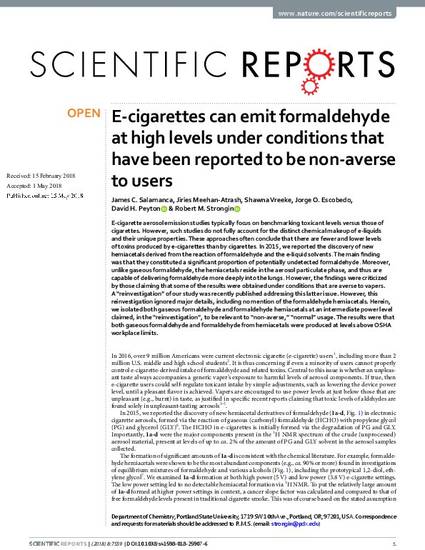
- Electronic cigarettes,
- Formaldehyde,
- Cancer -- Environmental aspects,
- Electronic cigarettes -- Health aspects,
- Electronic cigarettes -- Analysis,
- Electronic cigarettes -- Effect of high temperature on
E-cigarette aerosol emission studies typically focus on benchmarking toxicant levels versus those of cigarettes. However, such studies do not fully account for the distinct chemical makeup of e-liquids and their unique properties. These approaches often conclude that there are fewer and lower levels of toxins produced by e-cigarettes than by cigarettes. In 2015, we reported the discovery of new hemiacetals derived from the reaction of formaldehyde and the e-liquid solvents. The main finding was that they constituted a significant proportion of potentially undetected formaldehyde. Moreover, unlike gaseous formaldehyde, the hemiacetals reside in the aerosol particulate phase, and thus are capable of delivering formaldehyde more deeply into the lungs. However, the findings were criticized by those claiming that some of the results were obtained under conditions that are averse to vapers. A “reinvestigation” of our study was recently published addressing this latter issue. However, this reinvestigation ignored major details, including no mention of the formaldehyde hemiacetals. Herein, we isolated both gaseous formaldehyde and formaldehyde hemiacetals at an intermediate power level claimed, in the “reinvestigation”, to be relevant to “non-averse,” “normal” usage. The results were that both gaseous formaldehyde and formaldehyde from hemiacetals were produced at levels above OSHA workplace limits.

Open Access
This article is licensed under a Creative Commons Attribution 4.0 International License, which permits use, sharing, adaptation, distribution and reproduction in any medium or format, as long as you give appropriate credit to the original author(s) and the source, provide a link to the Creative Commons license, and indicate if changes were made. The images or other third party material in this article are included in the article’s Creative Commons license, unless indicated otherwise in a credit line to the material. If material is not included in the article’s Creative Commons license and your intended use is not permitted by statutory regulation or exceeds the permitted use, you will need to obtain permission directly from the copyright holder. To view a copy of this license, visit http://creativecommons.org/licenses/by/4.0/.
© The Author(s) 2018